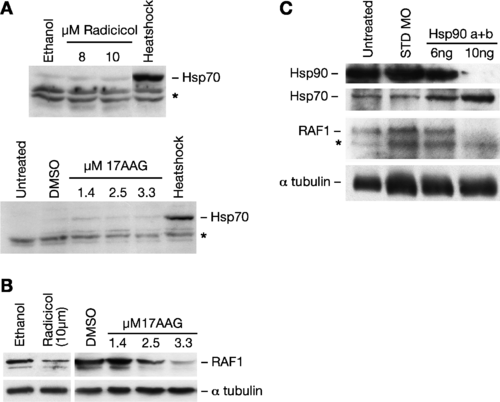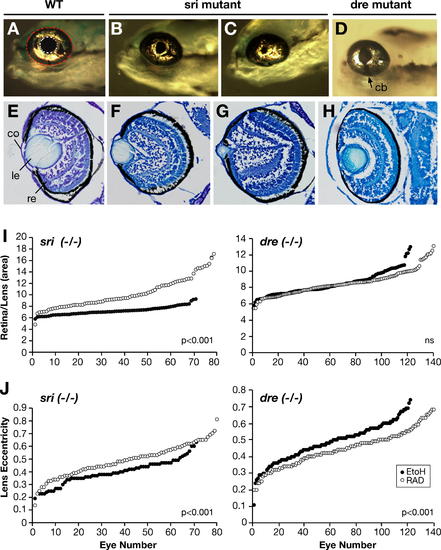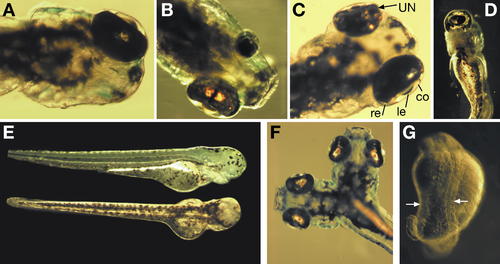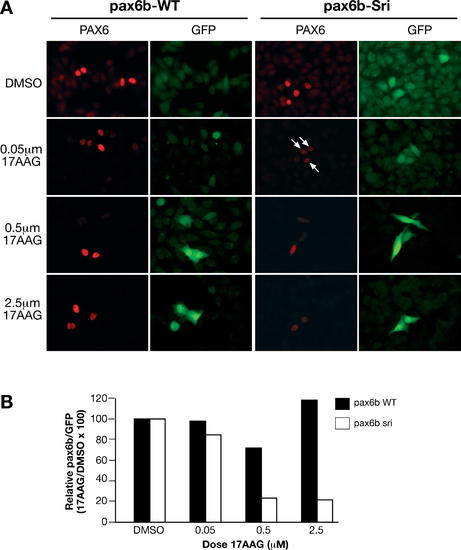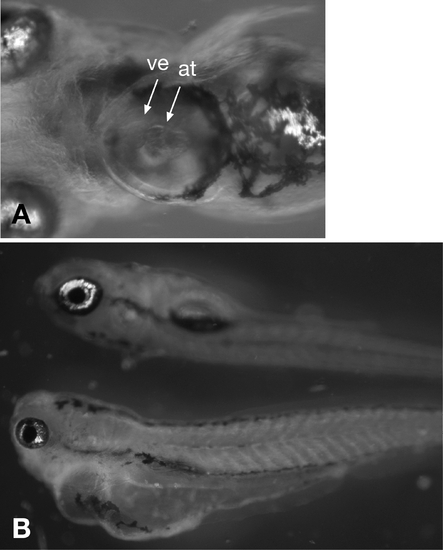- Title
-
Hsp90 Selectively Modulates Phenotype in Vertebrate Development
- Authors
- Yeyati, P.L., Bancewicz, R.M., Maule, J., and van Heyningen, V.
- Source
- Full text @ PLoS Genet.
|
Developmental Defects Observed among WT Strains after Decreasing Hsp90 Function at 30% Epiboly (A) Frequencies: Embryos were treated at 30% epiboly with 10 μM radicicol (blue) or 3.3 μM 17AAG (orange). Rate of survival is the relative percentage of live embryos at 48 hpf compared to the relevant control siblings. Abnormal heart looping includes heterotaxia and nonlooping of the heart tube; severely oedematous fish with consequently abnormal heart were excluded. (B–O) Examples of observed phenotypes: (B–D) Developmental delay observed at 24 hpf after treatments. Interrupted caudal fin fold (dotted lines) after radicicol (E) or 17AAG (F) treatment. Notochord folds (arrows) after radicicol (G) and 17AAG (H). Drug-induced heart oedema with abnormal heart morphology after radicicol (I) and 17AAG (J). Radicicol-induced mild oedema with abnormal heart looping (K). WT (L) or inverted heart looping after 17AAG (M), radicicol (N), or Hsp90 morpholino injections (O). Black arrows indicate the position of the ventricle. |
|
Assessment of Heat Shock Induction and Levels of Hsp90 Inhibition (A) Western blots to assess Hsp70 induction following overnight treatment of WT embryos initiated at 50% epiboly with increasing concentrations of radicicol or 17AAG. As positive control, Hsp70 was induced by incubating embryos at 37 °C for 30–60 min before harvesting. (B) Western blots showing graded reduction in RAF1, an Hsp90 client-protein, in response to inhibition by radicicol and 17AAG. (C) Western blots to assess Hsp90, Hsp70, and RAF1 levels in embryos injected with 6 ng of universal morpholino control (STD MO) or Hsp90 a+b morpholinos at the indicated individual amounts. α-tubulin was used as loading control. *, Nonspecific band showing equal loading EXPRESSION / LABELING:
|
|
Assessing Range of Expressivity and Quantifying Phenotype Modulation in sri and dre Strains (A–H) Phenotype of the sri and dre eye mutants at 5 dpf. (A–D) Lateral view of live embryos; (E–H) histological sections. (A) WT; lens (white-dotted lines) and retina (red-dotted lines) measurements were used to asses phenotypic severity; (E) WT section showing retina (re), lens (le), cornea (co); (B) and (F) sri mild and (C) and (G) sri severe; (D) dre with coloboma (cb); (H) dre showing flattened anterior segment. (I and J) Ranked plots showing distribution of quantitative eye parameters in treated (white circles) and sibling control (black circles) homozygous embryos: (I) Ratio of retina to lens area; (J) Lens shape or eccentricity. PHENOTYPE:
|
|
Eye Defects and Body-Axis Duplications Observed in AMN Populatio. Dorsal views shown are: (A) Unilateral anophthalmia; (B) Unilateral microphthalmia; and (C) Unilateral nanophthalmia (UN), illustrating retina (re), lens (le), cornea (co). (D) Ventral view of cyclopic embryo is shown. (E) Bilateral anophthalmia is shown (top, lateral view; bottom, dorsal view). (F) Anterior body-axis duplication (ABD), two complete heads formed; incomplete ABD were also observed (not shown). (G) Posterior body duplication (PBD), two notochords showing adjacent somite boundaries (arrows), culminating in two tails. |
|
Differential Sensitivity of WT and sri Mutant Pax6b Protein to Hsp90 Inhibition. Cells were cotransfected with either WT or sri mutant paxb cDNA and GFP reporter. (A) Representative field of HeLa cells transfected with Pax6b-WT or Pax6b-sri mutant immunohistochemically assessed for Pax6b protein levels (red) or control GFP frequency (green). Effects of treatment with different concentrations of 17AAG are shown compared with DMSO control. (B) Relative ratio of Pax6b positive (red cells) to GFP positive (green) cells for each treatment compared to the relevant DMSO control. The figures show one representative experiment from three independent experiments with similar results. |
|
Abnormal Phenotypes in Morpholino Injected Embryos (A) Absence of looping of the heart tube in Hsp90 morpholino-injected embryos. (B) Severe oedema in Hsp90 morpholino-injected embryos. |


